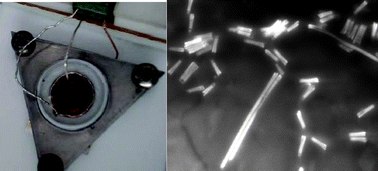We have recently reported that “luminescent” SixGe1−x can be electrodeposited from 1-butyl-1-methylpyrrolidinium bis(trifluoromethylsulfonyl)amide ([Py1,4]Tf2N) at room temperature. Interestingly, 1-ethyl-3-methylimidazolium bis(trifluoromethylsulfonyl)amide ([EMIm]Tf2N) ionic liquid delivers a germanium-rich SixGe1−x showing also a quantum-size effect, as revealed in the present study. These results led us to evaluate the possibility of obtaining high quality SixGe1−xnanowires from two different ionic liquids by the simple and inexpensive template-assisted electrochemical pathway. Herein, we report for the first time on the room temperature template synthesis of SixGe1−xnanowires by potentiostatic electrochemical deposition from the air- and water-stable ionic liquids [Py1,4]Tf2N and [EMIm]Tf2N containing (each) GeCl4 and SiCl4 as precursors. As a first step, a commercially available track-etched polycarbonate membrane (PC) with an average nominal pore diameter of 90 nm was used as template. SixGe1−xnanowires with an average diameter corresponding to the nanopores' diameter and lengths of 1 to 2.5 µm were reproducibly obtained. [EMIm]Tf2N delivers longer SixGe1−xnanowires than [Py1,4]Tf2N under the same parameters and reaction conditions. Characterization of the nanowires was performed by EDX and HR-SEM.

You have access to this article
 Please wait while we load your content...
Something went wrong. Try again?
Please wait while we load your content...
Something went wrong. Try again?


 Please wait while we load your content...
Please wait while we load your content...